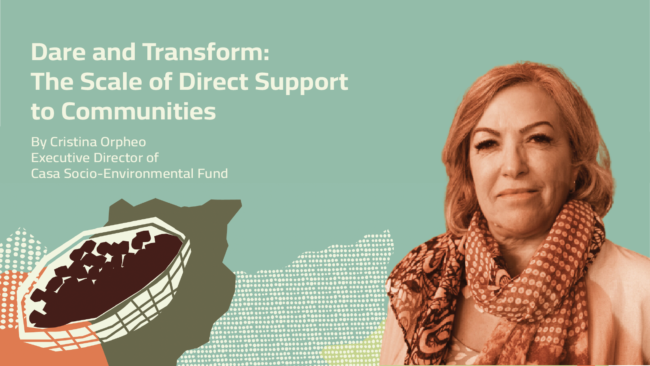 12.09.2024
12.09.2024
Dare and Transform: The Scale of Direct Support to Communities
By Cristina Orpheo – Executive Director of Casa Socio-Environmental Fund
Since I started my journey in the field of grantmaking, or of supporting projects as I prefer to call it, I realized that certain concepts, often treated as universal, prove diverse and complex when viewed from different perspectives. The meaning of “small” is a prime example of this complexity. Throughout my career, it has not been uncommon for me to hear questions like, “Such a small grant? What scale do you work on? How does this create impact?” However, these questions only make sense from a limited viewpoint, ignoring the diverse realities of the communities that receive these resources.
In the context of historically marginalized communities with few opportunities, a seemingly “small” grant can be transformative. What may seem insignificant to large financiers becomes a valuable resource in the hands of these communities, catalyzing profound and sustainable changes. At Casa Fund, we have long abandoned the notion of “small grants.” Instead, we talk about the right level of support, tailored to the management and absorption capacity of each group in its specific context. Over more than 19 years of operation, we have developed a grantmaking methodology that considers the particularities of each territory, people, and reality. More than 3,500 initiatives have been supported by this meticulous approach, demonstrating that impact is not measured by the size of the grant but by its appropriateness and effectiveness.
This approach is not unique to Casa Fund. Over the past 20 years, funds from the Global South have developed innovative and unique strategies to ensure that resources reach the community based groups that need them most, covering diverse audiences and thematic areas such as gender equality, LGBTQIAPN+ rights, and racial equity among others. In many cases, these funds were and are the only source of funding that these communities received to defend their rights and promote their projects. However, in the field of conservation philanthropy, a disconnected view persists around the issue of “how to make the money reach the grassroots,” resulting in a continuous waste of funds in search of solutions that already exist, but are ignored by them due to lack of trust, vision, daring and innovation, or pure shortsightedness.
The obsession with scale and impact has diverted recognition from an already structured and expanding field, capable of making money reach local communities like no other. Large foundations, public funds, and international cooperation, with their bureaucratic structures, face almost insurmountable difficulties in achieving this goal. However, is it really necessary for these structures to perform such a task when there are already mechanisms created and operated by those who best understand the needs and challenges of the communities?
It is known that funds from the Global South, whether local, activist, community, or territorial, are at different stages of maturity, with some reaching two decades of operation, while others are newer. But experience has already shown that funds close to and dedicated to their territories or themes are the most efficient and secure structure for channeling resources directly to local communities, in less time, and with proven exponential effects.
In a world where there is no more room for misguided strategies that do not put money directly into the hands of those on the front lines of the fight against poverty, deforestation, and for the conservation of forests, the tested structure of local funds from the Global South is a clear and distinct answer. And frankly, we no longer have time to waste on inventions and fanciful ideas that do not reflect the reality of the communities most important for the protection of life on this planet. The answers already exist, the solid structures too, and it is time to use them before we miss the last opportunities to make a real difference due to the vanity of those who do not know or deny an entire universe that Global South philanthropy has already built to perfection. Instead of questioning the scale and impact, the focus should be on competence, daring, and the ability to do differently.
Recently, Casa Fund signed an agreement with Caixa Econômica Federal (Brazilian public bank) worth approximately US$10 million, with US$8 million being directed to support 400 projects that will boost sociobiodiversity businesses and nature-based solutions. This initiative includes more than 40 capacity-building workshops in management and five face-to-face meetings to foster the exchange of experiences among the supported associations. It is a compelling response to those who still doubt the feasibility of a scalable and effective approach.
If there are still doubts, I suggest visiting quilombola, forest-dwellers, agroecological, and artisanal fishing communities across Brazil. There, with just 10 thousand dollars, these groups demonstrate efficiency and impact that defy the traditional logic of “large scale.” An organic network of collaboration connects these groups and keeps hope alive on a planet that could be in a much worse situation without these initiatives. To achieve the desired scale, money is indeed necessary, but it must be allocated in the right place, at the right time, and in the right way.
I am not afraid to talk about the importance of money, as an administrator that I am, in a world where most resources are distributed incorrectly – and philanthropy is no exception. If we balance this distribution better, the impact will be significantly greater. This is not the first time Casa Fund has made this type of partnership, but unfortunately, it is rare. Now, it is up to the large philanthropic foundations and the major existing financial mechanisms to have the courage to follow this path and bet on those who are, in fact, making a difference.
Let there be inspiration!
